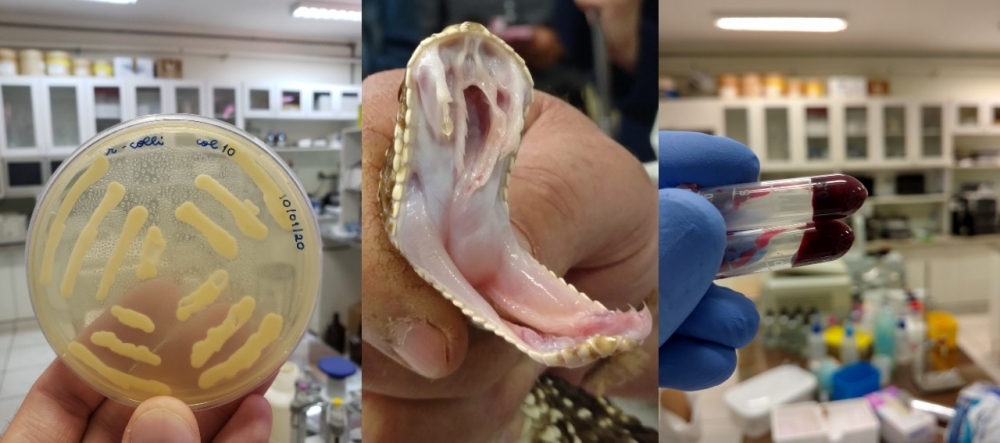

Procedure tested by researchers in Brazil and Belgium made the molecule more stable in the organism. Potential applications include anti-coagulants and wound dressings (photos: researchers’ archive)
Procedure tested by researchers in Brazil and Belgium made the molecule more stable in the organism. Potential applications include anti-coagulants and wound dressings.
Procedure tested by researchers in Brazil and Belgium made the molecule more stable in the organism. Potential applications include anti-coagulants and wound dressings.

Procedure tested by researchers in Brazil and Belgium made the molecule more stable in the organism. Potential applications include anti-coagulants and wound dressings (photos: researchers’ archive)
By André Julião | Agência FAPESP – Researchers in Brazil and Belgium have developed a molecule of pharmaceutical interest from collinein-1, a protein found in rattlesnake venom. They used a technique called PEGylation to make the molecule, now called PEG-rCollinein-1, more stable in the organism and resistant to the immune system, obtaining a drug candidate to modulate blood clotting.
An article reporting the results of the research has recently been published in the International Journal of Biological Macromolecules.
“The technique is designed to keep the molecule in the bloodstream for longer, increasing the time between administrations if it becomes a medication. It also reduces degradation of the molecule by components of the human organism and enhances its functional properties,” said Ernesto Lopes Pinheiro Júnior, first author of the article.
Currently a researcher at the Catholic University of Leuven in Belgium, Pinheiro-Júnior conducted the study as part of his PhD research at the University of São Paulo’s Ribeirão Preto School of Pharmaceutical Sciences (FCFRP-USP) in Brazil with a scholarship from FAPESP.
PEGylation consists of binding polyethylene glycol (PEG) to the molecule of interest, reducing interaction with the immune system, and preventing formation of aggregates that inhibit the efficacy of the molecule’s action.
“PEGylation is fairly common in the pharmaceutical industry. Nineteen drugs manufactured with the technique have been approved to date. This is the first time it’s been used in an animal toxin in its recombinant form [produced in the laboratory by a genetically modified fungus],” said Eliane Candiani Arantes, a professor at FCFRP-USP and principal investigator for the study.
Arantes is also principal investigator for the FAPESP-funded project “Bioprospection of animal toxins with biotechnological interest through omic tools”.
Venom and medication
Obtained from the venom of Crotalus durissus collilineatus, collinein-1 consumes fibrinogen, a protein produced by the liver that helps blood clots to form. As a component of snake venom, collinein-1 promotes bleeding in the victim of a snake bite. When isolated and administered in small doses, it can prevent the formation of clots that cause stroke. When applied directly to the skin in a dressing, it can have the opposite effect, causing blood to clot in a wound that is healing too slowly.
Obtaining a sufficient quantity of the molecule directly from snakes, however, would require maintaining a large serpentarium staffed by professionals trained to extract their venom. The group had solved this problem in previous research.
While working on her master’s research at the Federal University of Uberlândia (UFU) in Minas Gerais, Brazil, Johara Boldrini-França, second author of the article, cloned the gene that encodes collinein-1 and later created a version of the yeast Pichia pastoris that carries this gene. The P. picharis expression system is a standard molecular biology tool for the production of recombinant proteins.
Boldrini-França’s study, for which Arantes was also principal investigator, continued during her doctoral research and postdoctoral research at FCFRP-USP.
“This strategy is widely used in the pharmaceutical industry. Part of manufactured insulin, for example, comes from yeasts that produce this human protein,” said Boldrini-França, currently a postdoctoral researcher at the University of Vila Velha (UVV) in Espírito Santo state (Brazil).
In addition to not depending on venom extraction from snakes, the advantages include easy manipulation of the microorganism in the laboratory, low cost, and mass production in bioreactors.
Cancer
During a postdoctoral research internship at the Catholic University of Leuven under the supervision of Professor Jan Tytgat, Boldrini-França decided to test the recombinant protein (rColleinin-1, the version produced by the yeast) on structures found in various kinds of tumor.
“It seemed unlikely to succeed, as collinein-1 is a large protein, and smaller molecules are typically tested on ion channels, which are targets for some cancer drugs,” Arantes explained.
To the group’s surprise, the recombinant protein acted on a certain type of potassium channel present in a breast cancer cell line, inhibiting activity in the channel without affecting healthy tissue. This study was described last year in Scientific Reports.
When the PEGylated version of the molecule was used, however, there was no anti-cancer activity. “The molecule’s capacity to combat cancer doesn’t depend on enzymatic activity but on its size, as it blocks the potassium channel. PEGylation made it too big and it failed to fit this target” Boldrini-França said.
“In many cases, PEGylation can take a molecule from the lab to the industry. That’s what we plan to do now,” Pinheiro-Junior concluded.
The research is part of two projects supported by FAPESP (2011/23236-4, and 2015/17286-0), as well as a PhD scholarship and a postdoctoral scholarship.
The article “Towards toxin PEGylation: The example of rCollinein-1, a snake venom thrombin-like enzyme, as a PEGylated biopharmaceutical prototype” is at: www.sciencedirect.com/science/article/abs/pii/S0141813021019164.
Republish
The Agency FAPESP licenses news via Creative Commons (CC-BY-NC-ND) so that they can be republished free of charge and in a simple way by other digital or printed vehicles. Agência FAPESP must be credited as the source of the content being republished and the name of the reporter (if any) must be attributed. Using the HMTL button below allows compliance with these rules, detailed in Digital Republishing Policy FAPESP.





